 Image search results - "Kyoto" Image search results - "Kyoto" |

One of Kyoto's Big Three Festivals held on May 15. The Aoi Matsuri's colorful procession of over 500 people in Heian-Period costumes start off at the Kyoto Gosho Imperial Palace and head for the Shimogamo and Kamigamo Shrines. Kyoto Gosho Imperial Palace 京都御所: The first ox carriage waits for the procession to start. The ox carriage is called a gissha. 牛車
|
|

Torokko train at Arashiyama for Hozu Gorge
|
|

Kameyama Castle is now headquarters to a religion called Omoto-kyo which acquired the castle property in 1919. Only stone walls and moats remain.Statue of shachihoko.
|
|

PR poster for the Kamogawa Odori geisha dance held during May 1-24 in Pontocho.
|
|

Nijo-jo castle was built on the order of Tokugawa Ieyasu to serve as the Kyoto residence for the Tokugawa shoguns. Although it does not have a castle tower, Nijo-jo Castle is Japan's best preserved and most magnificent castle palace.Seinan-sumi (Southwest corner) Turret is the first castle building you see when you walk from the station. Important Cultural Property 西南隅櫓
|
|

PR poster designed by Tetsuo OshiroPoster for the race.
京都大学ボート部OBの尾城徹雄様に作成したポスター。大学内や大津市石山商店街などで張り出された。
|
|
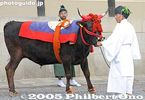
The bull was mooing all the time and was very restless.Do bulls moo or do they snort? This was making a loud noise.
|
|

Pontocho Kaburenjo theater, venue for Kamogawa Odori.
|
|
|
|

Kameyama Castle was built by Akechi Mitsuhide in the 16th century as his base for his conquered Tanba region.
|
|
|

Norijiri horseman leads the procession. 乗尻The procession, called Roto-no-Gi (路頭の儀), is actually one of three rites performed during the festival.
|
|
|
|

Statue of shachihoko roof ornament
|
|

Pontocho is a narrow alley and known as a geisha district.
|
|
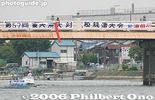
Karahashi Bridge as the starting point for alumni races
|
|

Minami-mon (South) Gate 南門
|
|

10:30 am: Starting point at Kyoto Gosho Imperial Palace 京都御所 出発The procession is ready to depart.
|
|

Dance program for 2005.
|
|
|
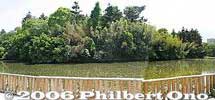
Castle compound and moat
|
|

Tonan-sumi (Southeast corner) Turret, Important Cultural Property 東南隅櫓
|
|

The procession basically consists of two columns: The Hon-retsu which includes the procession's highest-ranking official called Chokushi. It consists of men. The second and longer column is the Saio-dai-retsu consisting of women.
|
|

Barrels of sake next to the theater.
|
|

Hozu River
|
|

Castle moat
|
|

Kyoto Univ. in dark blue T-shirts
|
|

Tonan-sumi (Southeast corner) Turret 東南隅櫓
|
|

"Heian" comes from "Heian-kyo," the former name of Kyoto city.
|
|

Hozu Gorge
|
|
|
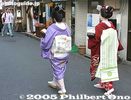
A geisha/geiko and maiko head to the theater to see the Kamogawa Odori. Notice the different obi sash on the back.A maiko is an apprentice geisha. Her obi sah on the back is long, as well as her sleeves.
|
|
|
|

Tonan-sumi (Southeast corner) Turret 東南隅櫓
|
|

The Heian Period was when Kyoto was the capital of Japan where the Emperor resided.
|
|
|

Entrance to Omoto-kyo HQ and former castle grounds
|
|

Pontocho Kaburenjo theater
|
|

Finish line 300 meters later
|
|

Tonan-sumi (Southeast corner) Turret 東南隅櫓
|
|

The Aoi Matsuri (Festival) used to be called Kamo-sai, after the name of the two shrines which hold the festival.賀茂祭
|
|
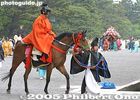
One of six court dancers called maibito. 舞人
|
|

Train station platform
|
|
|

Geiko and maiko in front of Pontocho Kaburenjo theater
|
|

Tokyo Univ. (Todai) crew return to land after a race
|
|

Tonan-sumi (Southeast corner) Turret 東南隅櫓
|
|

The procession's highest-ranking official called Chokushi. An Imperial Messenger. The horse is highly decorated. 勅使
|
|

Entrance to Pontocho Kaburenjo theater. You can buy tickets for the day's performance.
|
|

Shooting the rapids
|
|
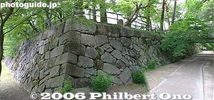
Stone foundation
|
|
|
|
|

The Aoi Matsuri started in the early Heian Period in the 8th century as a national or state-sponsored event.
|
|

Ogre on the train
|
|
|

Inside the theater, waiting for the start of the 168th Kamogawa Odori (in 2005) to start.
|
|
|

On July 16, the night before the Gion Matsuri Yamaboko Junko parade of floats, the Yoiyama display of floats lit up at night attract huge crowds in central Kyoto. You can also enter some of the grand floats.
|
|

Kyoto Station
|
|

May 15, the day of the procession, is the festival's climax. However, there are other festival-related ceremonies and events before this day.
|
|

Ogre posing
|
|
|

Part 1 Monogusa Soshi: Taro's Shack. Lazy Taro does nothing but compose poems all day in his shack. 物ぐさ草紙 太郎の小屋The first half is a musical play with a storyline.
|
|

Univ. of Tokyo alumni crew in light blue T-shirts
|
|

Ninomaru Higashi Otemon Gate (Main entrance), Important Cultural Property 二之丸東大手門
|
|

Even before evening comes, a large crowd stop to see the Naginata-boko float at Shijo-Karasuma.
|
|

Kyoto Station
|
|

Over 500 people in the procession walk along the 8-kilometer route.There's a lunch break at around noon at Shimogamo Shrine.
|
|

Most take the train from Arashiyama, then ride the boat back.
|
|
|

Taro's Shack
|
|

Kyoto Univ. alumni crew in dark blue T-shirts
|
|

Ninomaru Higashi Otemon Gate (Main entrance) 二之丸東大手門
|
|

People vying to see Naginata-boko float.
|
|

Kyoto Tower as seen from the open-air roof of Porta shopping mall.
|
|
|
|

End of the gorge
|
|
|
|

Kyoto Tower at night.
|
|

Kyoto Univ. alumni crew at start line
|
|

Guard house and Ninomaru Higashi Otemon Gate (Main entrance) 二之丸東大手門
|
|

Bridge to the float.
|
|

Hiroshige's woodblock print of Kameyama (47th post town on the Tokaido) from his "Fifty-Three Stations of the Tokaido Road" series. Kameoka was formerly named Kameyama.
|
|

Flower umbrella called furyu-gasa. 風流傘Flowers are artificial.
|
|

Kameoka Station
|
|

Magistrate's House
|
|

On Karahashi Bridge
|
|

Guard house
|
|

Maiko alert
|
|

Flower umbrella
|
|
|
|

Race starts for Kyoto Univ. alumni
|
|

Tonan-sumi (Southeast corner) Turret 東南隅櫓
|
|

Maiko poses in front of the Naginata-boko float across the street in Kyoto
|
|

Saio-dai Princess procession. 斎王代
|
|
|
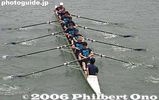
Kyoto Univ. alumni
|
|

Karamon Gate, Important Cultural Property. 唐門
|
|

A real crowd pleaser. Thanks for posing!
|
|

Closeup of Nijo Castle's Karamon Gate
|
|

Closeup of Nijo Castle's Karamon Gate
|
|

Saio-dai Princess procession. 斎王代
|
|
|
|

Kyoto Univ. starts to veer off course
|
|

Ninomaru Palace, National Treasure 二之丸御殿
|
|

Maiko pose
|
|

The Saio-dai Retsu column begins. Consists of all women, highlighted by the Saio-dai Princess.
|
|

Taro overhears the Lord's daughter trying to compose a poem.
|
|

Kyoto Univ. is unable to correct their misdirection
|
|

Ninomaru Palace entrance, National Treasure. Open to the public, but photography inside is not allowed. 二之丸御殿
|
|

Side street of food and souvenir stalls
|
|

High-ranking lady of the court
|
|
|
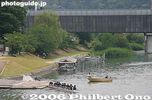
A faulty rudder runs them aground
|
|

Palace entrance roof
|
|

Yamabushi-yama residence opened up for public display
|
|

JR Yamashina Station
|
|

Court ladies called myobu. 命婦
|
|

Taro helps her compose her poem.
|
|
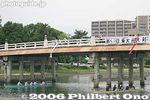
4-man crew alumni boat race
|
|

Ninomaru Palace side view facing the garden. National Treasure
|
|

Yamabushi-yama 山伏山
|
|

Court lady called myobu. 命婦
|
|

Taro has a scuffle with the daughter and breaks her koto instrument.
|
|
|

National Treasure
|
|

Yamabushi-yama
|
|

Keihan Yamashina Station is right next to JR Yamashina Station on the right.
|
|

Court lady called myobu. 命婦
|
|

Mother scolds the daughter for the scuffle with Taro.
|
|
|
|

Ninomaru Palace side view facing the garden.
|
|

Tenjin-yama 天神山
|
|
|
|
|

8-man crew alumni in their 20s and 30s at starting line
|
|

Ninomaru Garden
|
|

Tenjin-yama
|
|
|
|
|
|

Ninomaru Garden
|
|

Souvenir hunters. Cheap geta clogs and yukata (made in China) are sold.
|
|
|
|

Kyodai alumni in their 20s and 30s
|
|

Castle map
|
|

Geta for 600 yen
|
|
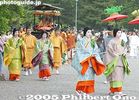
斎王代
|
|

It turns out that Taro was a grandson of the Emperor.
|
|

Kyodai alumni in their 20s and 30s
|
|

East Bridge to Honmaru and Honmaru Yagura-mon Gate
|
|

Maiko in my midst
|
|
|
|
|

Saio-dai Princess riding on a special palanquin called Oyoyo. 斎王代 腰輿(およよ)腰輿(およよ)
|
|
|
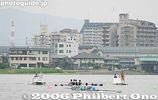
One of the main events, the 4-man boat race between Todai and Kyodai on a 3200-meter course.
|
|

Honmaru PalaceImportant Cultural Property
本丸御殿
|
|

Yoshikawa
|
|
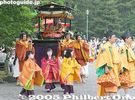
The Saio-dai Princess in 2005 was Saito Ayako, a 21-year-old Kyoto native and student at Doshisha Univ. Her 12-layer juni-hitoe kimono weighs 30 kg. 斎王代、齋藤彩子さん(21)The Saio-dai Princess is selected every year in April and a press conference is held to announce who was chosen. She is always a native of Kyoto, single, and in her early 20s. The Saio-dai was first incorporated in the festival in 1956. In 2005, she is the 50th Saio-dai.
Read more about here.
|
|

Taro gets to marry the lord's daughter.
|
|

Todai's 4-man crew in the lead
|
|

Foundation of castle tower天守閣跡
|
|

Yoshikawa: A special treat is that private residences in the old kimono merchant district open up their entryways to show folding screens, kimono, and other treasures.
|
|

The Saio-dai Princess is the main figure of the procession. She represents the Imperial princess who worked at the Kamo Shrine and served in the Aoi Festival during the Heian Period.腰輿(およよ)
|
|
|
|

Kyodai's 4-man crew try to keep up
|
|

Top of castle tower foundation天守閣跡
|
|

Yoshikawa
|
|
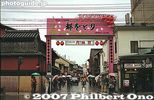
Entrance to the road leading to the Cherry Dance theater (Gion Kobu Kaburenjo) in the Gion district. The sign says "Miyako Odori."
|
|

Pagoda and maiko
|
|
|
|

Todai's 4-man crew rowing
|
|

Top of castle tower foundation天守閣跡
|
|

Matsuzakaya 松坂屋
|
|

More signposts reading "Miyako Odori." "Miyako" means capital (Kyoto was once Japan's capital city), and "Odori" means dance.
|
|

Court ladies called uneme. Their kimono have a blue wave design. 釆女釆女
|
|

End of Part 1 with a happy ending.
|
|

Kyodai's 4-man crew rowing
|
|

Castle tower foundation天守閣跡
|
|
|
|
|

"Miyako Odori" sign post. Performed for over a century, the dance makes April a very special time in Kyoto. It helps to hone the dance and musical skills of the geiko and maiko who diligently practice for this annual dance.
|
|

Shrine maiden on horseback called Munanori Onna. 騎女They escort the Saio-dai Princess.
|
|

Part 2: Passing of Spring in Kyoto, "Nanohanaya" (Rape blossoms) 菜の花やPart 2 of the program consists of dance numbers.
|
|

Kyodai's 4-man crew rowing with dark-blue blades
|
|

Honmaru Palace as seen from the castle tower foundationImportant Cultural Property
|
|

Teens in yukata
|
|

Shrine maiden on horseback called Munanori Onna. They escort the Saio-dai Princess.騎女
|
|

"Nanohanaya" (Rape blossoms) 菜の花や
|
|

Todai won this one.
|
|

Honmaru PalaceImportant Cultural Property
|
|

If you like women in yukata, see the Yoiyama (or Yoiyoiyama or Yoiyoiyoiyama during the three evenings before the main Gion Matsuri parade).
|
|

"Miyako Odori" poster in English.
|
|

"Miyako Odori" poster and paper lantern.
|
|

Shrine maiden on horseback called Munanori Onna.騎女
|
|

"Nanohanaya"
|
|
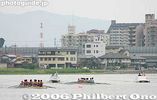
Main race: 8-man crew for Todai and Kyodai coming round the bend on the 3200-meter course
|
|

Moat between Ninomaru (left) and Honmaru (right)East Bridge in the distance.
|
|

Side street to Minami Kannon-yama float
|
|
|
|

Shrine maiden on horseback called Munanori Onna.騎女
|
|

"Nanohanaya"
|
|

Ninomaru Kita Otemon GateImportant Cultural Property
二之丸北大手門
|
|

Minami Kannon-yama float
|
|

PR posters and paper lanterns for the Miyako Odori are everywhere.
|
|

Shrine maiden on horseback called Munanori Onna.騎女
|
|

"Nanohanaya" (Rape blossoms) 菜の花や
|
|

Kyodai is clearly in the lead
|
|

Warehouse wall
|
|

Minami Kannon-yama float
|
|

Ichiriki, a famous geisha tea house.
|
|

With over 30 horses in the procession, this guy will be kept busy...
|
|

"Nanohanaya" (Rape blossoms). They dance like they were melting into the sea of flowers. 菜の花や
|
|

Kyoto Univ. rowing to victory
|
|

Tonan-sumi Turret from the street
|
|

Minami Kannon-yama float and flute players
|
|

Maiko and geisha can often be seen in Gion.
|
|

Following the Saio-dai Princess are more high-ranking ladies of the court.
|
|

"Nanohanaya" (Rape blossoms) 菜の花や
|
|

A plastic sheet protects the tapestry from rain (it was a cloudy day)
|
|

Gate to Kobu Kaburenjo Theater. Four shows daily in April, lasting about 1 hour (too short). Ticket prices range from 1900 yen to 4300 yen.
|
|
|

"Irises" are in full bloom. 菖蒲
|
|

Univ. of Tokyo rowing
|
|

Crowd on one of the main streets
|
|

Gate to Kobu Kaburenjo Theater. You can make ticket reservations by phone, or go directly to the theater ticket office and buy tickets.
|
|
|

"Irises" 菖蒲
|
|

Kyoto University's winning rowing crew
|
|
|

Kobu Kaburenjo Theater
|
|
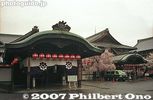
Gion Kobu Kaburenjo Theater. Ticket office is on the right. Best to buy tickets at least a few days in advance.
|
|
|

"Irises" 菖蒲 She rises from beneath the stage.
|
|

Carrying the boat back
|
|

Crowd on Shijo-dori street
|
|
|
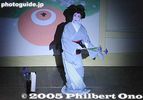
"Irises" She holds an iris flower. She just took a bath with iris leaves. 菖蒲
|
|

View of Seta River race course, Karahashi Bridge on far left. Tokyo vs. Kyoto Univ. Regatta
|
|

Awards ceremony
|
|

Crowd and floats on Shijo-dori street as darkness sets in.
|
|
|

"Irises" 菖蒲
|
|

Kanpai!
|
|

Crowd and floats om Shijo-dori street 四条通り
|
|
|

Comical play called "Kyogen Furyu" 狂言風流
|
|
| 2894 files on 12 page(s) |
1 |
 |
 |
 |
 |
|